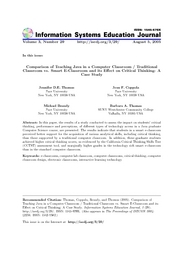Volume 3
Volume 3, Number 29 |
August 5, 2005 |
Abstract: In this paper, the results of a study conducted to assess the impact on students' critical thinking, performance and perceptions, of different types of technology access in a Java graduate Computer Science course, are presented. The results indicate that students in a smart e-classroom perceived better support for the acquisition of various analytical skills, including critical thinking, than those supported by a traditional computer classroom. In addition, these graduate students achieved higher critical thinking scores, as evidenced by the California Critical Thinking Skills Test (CCTST) assessment tool, and marginally higher grades in the technology rich smart e-classroom than in the standard computer classroom.
Keywords: e-classrooms, computer lab classroom, computer classrooms, critical thinking, computer classroom design, electronic classrooms, interactive learning technology
Download this issue: ISEDJ.3(29).Thomas.pdf (Adobe PDF, 8 pages, 694 K bytes)
Preview the contents: Thomas.v1.txt (ASCII txt, 17 K bytes)
Recommended Citation: Thomas, Coppola, Braudy, and Thomas (2005). Comparison of Teaching Java in a Computer Classroom / Traditional Classroom vs. Smart E-Classroom and its Effect on Critical Thinking: A Case Study. Information Systems Education Journal, 3 (29). http://isedj.org/3/29/. ISSN: 1545-679X. (A preliminary version appears in The Proceedings of ISECON 2004: §2234. ISSN: 1542-7382.)
